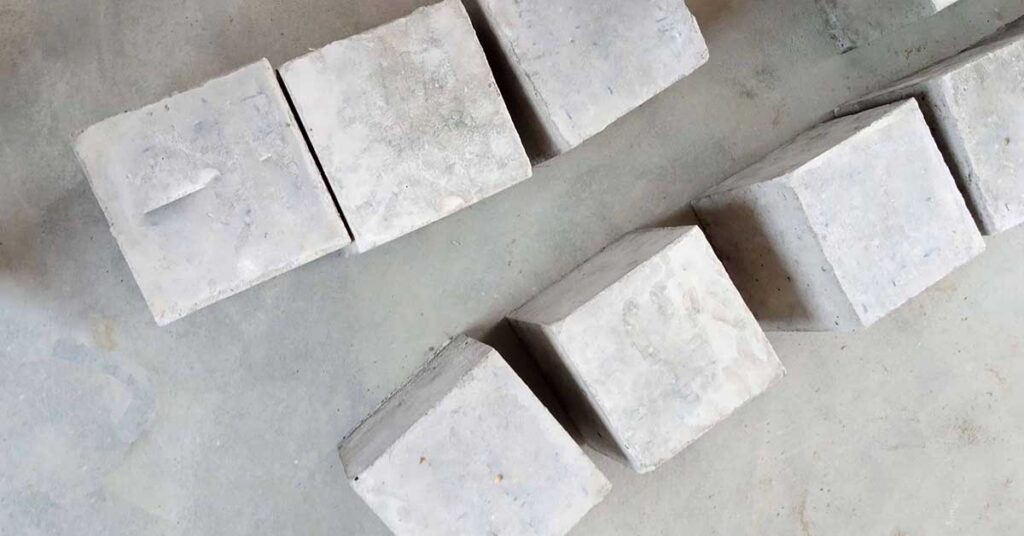Concrete is a building material used in various construction projects due to its strength and durability. One of the key properties of concrete is its compressive strength, which refers to the ability of the material to withstand loads that are applied to it. Compressive strength is an important factor in the design of concrete structures, as it determines the load-bearing capacity of the material.
The compressive strength of concrete is usually measured in pounds per square inch (psi). The strength of concrete is affected by various factors, including the type and amount of cement used, the ratio of water to cement, the size and shape of the aggregate, and the curing process.
The American Concrete Institute (ACI) recommends a minimum compressive strength of 2500 psi for residential concrete and 4000-5000 psi for commercial and industrial concrete. These values can vary depending on the specific requirements of the project and the local building codes.
There are several methods to test the compressive strength of concrete, including the standard cylinder test, the cube test, and the pull-out test. In the cylinder test, a cylindrical concrete sample is subjected to compressive loads using a compression testing machine. The cube test involves testing small concrete cubes under compressive loads. The pull-out test involves attaching a concrete cylinder to a metal plate and applying a compressive load until the cylinder is pulled out of the plate.
Procedure: Compressive Strength Test of Concrete Cubes as per ASTM
The American Society for Testing and Materials (ASTM) has established standard test methods for determining the compressive strength of concrete. The procedure for conducting the compressive strength test of concrete cubes as per ASTM C39 is as follows:
1. Preparation of the specimens:
The concrete cubes are prepared from the fresh concrete mixture. The specimens are molded in a cube shape with dimensions of 150mm x 150mm x 150mm. The specimens are then cured in water for a specified period of time, usually 7, 14, or 28 days.
2. Placing the specimens in the testing machine:
The specimens are placed in the testing machine in such a way that the load is applied evenly on the surface of the specimens.
3. Applying the load:
The load is applied gradually at a constant rate until the specimen fails. The maximum load at which the specimen fails is recorded as the compressive strength of the concrete.
4. Calculating the compressive strength:
The compressive strength of the concrete is calculated by dividing the maximum load applied during the test by the cross-sectional area of the specimen. The cross-sectional area is calculated by multiplying the width and height of the specimen.
5. Reporting the results:
The compressive strength of the concrete is reported in pounds per square inch (psi) or megapascals (MPa). The results of the test are usually reported as the average compressive strength of three specimens.
It is important to follow proper testing procedures and use the correct equipment to ensure accurate and reliable results. The compressive strength of concrete is an important factor in the design of concrete structures, and it is essential to ensure that the concrete used in the construction meets the required strength specifications.
Apparatus for Compressive Strength Test of Concrete
The apparatus required for the compressive strength test of concrete includes:
- Compression Testing Machine
- Molds
- Scale
- Calipers
- Trowels
- Curing Membrane or Plastic sheet
- Curing Tank
Compression Testing Machine:
This is the main apparatus used to apply the compressive load on the concrete specimen. It typically consists of a loading platens, an actuator (manual or electronic), and a loading frame.
Molds:
These are used to cast the concrete specimen. The molds are typically cylindrical or cubic in shape and are made of steel or plastic.
Curing Tank:
This is used to cure the concrete specimen for a specified period of time before testing. A curing tank is typically used to provide a controlled environment for the concrete specimen to cure.
Scale:
This is used to measure the weight of the concrete specimen.
Calipers:
These are used to measure the dimensions of the concrete specimen, such as the width, height, and length.
Trowels:
These are used to smooth the surface of the concrete specimen before testing.
Curing Membrane or Plastic sheet:
This is used to cover the concrete specimen after casting and before curing, to prevent the loss of moisture.
It is important to ensure that all of the apparatus are calibrated and in good working condition before performing the compressive strength test. Also, the apparatus should be cleaned and maintained properly to ensure accurate test results.
Sampling of Cubes for Test
Sampling of cubes for the compressive strength test of concrete is a critical step in obtaining representative and accurate test results. The procedure for sampling cubes for the test is as follows:
-
Select the sampling location:
The cubes should be taken from the same location as the concrete that is being tested. This can be from the batching plant, the mixer truck, or from the structure itself.
-
Prepare the cube Molds:
Clean and oil the cube molds to prevent the concrete from sticking.
-
Take the sample:
Take at least three cubes from the fresh concrete and cast them in the cube molds. Care should be taken to ensure that the concrete is thoroughly mixed and placed in the molds in a homogenous manner.
-
Compact the concrete:
Compact the concrete in the molds using a vibration table or by hand, to remove any trapped air and to ensure proper compaction.
-
Cure the cubes:
Cover the cubes with a curing membrane or plastic sheet and store them in a curing tank or moist room for the specified curing period before testing.
-
Test the cubes:
After the curing period, remove the cubes from the molds and test them for compressive strength using a compression testing machine.
It is important to note that the number of cubes required for testing may vary depending on the project specification, however, generally at least three cubes are tested to obtain an average compressive strength. Also, the cubes should be tested at the appropriate age as specified in the project specification or standard.
Percentage Compressive Strength of Concrete at Various Ages
The compressive strength of concrete increases as it ages. The percentage of compressive strength at various ages can be represented in the form of a table as follows:
| Age | Percentage of Compressive Strength |
|---|---|
| 3 days | 40% |
| 7 days | 60-65% |
| 28 days | 95-100% |
It is important to note that the compressive strength of concrete can vary depending on the mix design, curing conditions, and quality control during the mixing and casting process. The above table is based on normal curing conditions and standard mix design.
Also, it should be noted that the compressive strength of concrete at 28 days is considered as the reference strength and is commonly used as a measure of the quality of concrete. It is important to test the concrete at the appropriate age as specified in the project specification or standard.
Compressive Strength of Different Grades of Concrete at 7 and 28 Days
| Grade of Concrete | Minimum compressive strength (N/mm2) at 7 days | Specified characteristic compressive strength (N/mm2) at 28 days |
|---|---|---|
| M15 | 10 | 15 |
| M20 | 13.5 | 20 |
| M25 | 17 | 25 |
| M30 | 20 | 30 |
| M35 | 23.5 | 35 |
| M40 | 27 | 40 |
| M45 | 30 | 45 |
Conclusion
It is important to ensure that the compressive strength of concrete meets the required specifications, as the strength of the material plays a critical role in the overall integrity and safety of the structure. If the compressive strength is too low, the concrete may not be able to withstand the loads applied to it, leading to potential structural failures.
In conclusion, compressive strength is a key property of concrete that determines its load-bearing capacity and its suitability for various construction projects. Proper testing and quality control measures are essential to ensure that the compressive strength of concrete meets the required specifications and standards.



